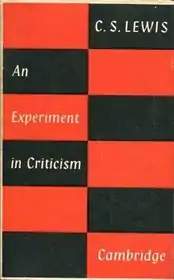An Experiment in Criticism
An Experiment in Criticism is a 1961 book by C. S. Lewis in which he proposes that the quality of books should be measured not by how they are written, but by how they are read. To do this, the author describes two kinds of readers. One is what he calls the "unliterary", and the other the "literary". He proceeds to outline some of the differences between these two types of readers. For example, one characterization of a unliterary reader is that the argument "I've read it before" is a conclusive reason not to read a book. In contrast, literary readers reread books many times, savouring certain passages, and attempting to glean more from subsequent readings.
 First edition | |
| Author | C. S. Lewis |
|---|---|
| Country | England |
| Language | English |
| Subject | Criticism |
| Publisher | Cambridge University Press |
Publication date | 1961 |
| Media type | |
| Pages | 142 |
| ISBN | 0-521-42281-7 |
| OCLC | 1018690 |
| 801.9 | |
| LC Class | LCC PN85.L48 |
Lewis also argued that judging books by whether they are "lowbrow" or "highbrow" is not necessarily fruitful; many "lowbrow" books prove to be valuable to a literary reader willing to approach without prejudgment. He noted that books classified as "lowbrow", such as science fiction, are also capable of inducing a passion to re-read and imparting experience which changes reader's worldview. Lewis suggests that books which are capable of doing this may prove to have enduring merit regardless of their genre of origin. He suggested that attempting to judge the literary merit of books based on traditional criteria may not prove fruitful.
Thus Lewis suggests that a "quality book" may be defined as one that someone – anyone – will re-read. Some such books will be judged by "highbrow" readers as being of poor quality; this view is deficient in that it has failed to appreciate those qualities which have merited re-reading.
External links
- An Experiment in Criticism at Faded Page (Canada)
- The Complete Review's review of An Experiment in Criticism